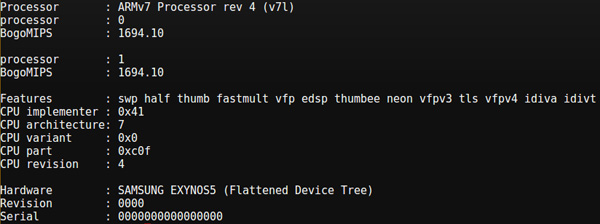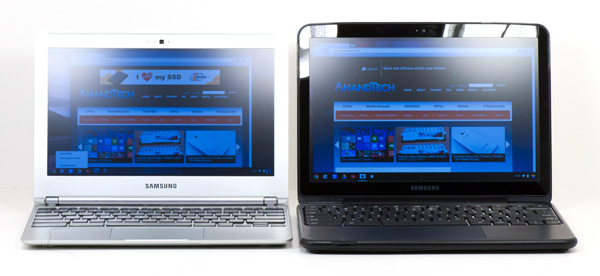Samsung Chromebook (XE303) Review: Testing ARM's Cortex A15
by Anand Lal Shimpi on October 31, 2012 9:00 AM ESTPerformance: Atom vs. ARM's Cortex A15
In our iPhone 5 review I included this crude diagram comparing the high level micro-architecture layouts of the current crop of mobile CPU cores. While most of the cores looked fairly similar, the one to really stand out is ARM's Cortex A15. A three issue, OoO core, the Cortex A15 was designed to put ARM in a completely new performance category.

For 2013, the Cortex A15 is expected to be the ARM CPU core of choice for the next wave of smartphone and tablet SoCs. NVIDIA's Wayne should integrate multiple Cortex A15s as well as competing solutions from Samsung and TI. Samsung's Exynos 5 Dual, found in the new Chromebook, integrates two ARM Cortex A15 cores running at 1.7GHz. As our first experience with a Cortex A15, I wanted to get a good idea for how it would compare to Intel's Atom. And now me comparing to the older Chromebook 500 makes sense. The Atom N570 in the older Chromebook is the closest approximation we have to the currently shipping Atom based mobile SoCs. There are a number of enhancements to the newer chips (particularly when it comes to power consumption), but the base core is very similar. It's clear that the Sandy Bridge Celeron based Chromebook is faster than this new Cortex A15 design, but how about the old dual-core Atom model?

As Chrome OS is built around the Chrome browser, our tests had to be largely JavaScript based unfortunately. The good news is that even given the nature of the benchmarks, we're able to get a good feel for performance between the two SoC platforms. Both systems were running the latest version of Chrome OS at the time of publishing.
| Samsung Chromebook Performance Comparison | ||||||
| SunSpider 0.9.1 | BrowserMark | RIABench Focus Tests | Kraken | |||
| Atom N570 1.66GHz | 1034.3 ms | 152780 | 1968 ms | 14229.5 ms | ||
| Exynos 5 Dual 1.7GHz | 690.5 ms | 217031 | 1192 ms | 9733.2 ms | ||
The Cortex A15 is fast. Across the board we're seeing a 40 - 65% increase in performance over a dual-core Atom. Although it's not clear how performance will be impacted as companies work to stick Cortex A15 based SoCs in smartphones with tighter power/thermal budgets, in notebooks (and perhaps even tablets) the Cortex A15 looks capable of delivering a good 1 - 2 generation boost over Intel's original Atom core.
The IE10 browser tests tend to agree with our JavaScript performance tests, although the CSS Maze Solver benchmark shows a huge advantage for ARM over Intel's Atom here.
| Samsung Chromebook Performance Comparison | ||||||
| IE10 Bubbles Test | IE10 Fishbowl | IE10 Maze Solver | ||||
| Atom N570 1.66GHz | 11 fps | 5 fps | 45 seconds | |||
| Exynos 5 Dual 1.7GHz | 17 fps | 8 fps | 17 seconds | |||
GPU performance is an even bigger advantage for the Exynos 5 Dual over Intel's old Atom N570 (GMA-3150 GPU). I ran three different webGL tests, each of which showed just how bad the old Atom GPU core was.
| Samsung Chromebook GPU Performance Comparison | ||||||
| WebGL Solar System | WebGL Cubes (500) | WebGL Aquarium (50) | ||||
| Atom N570 1.66GHz | 2 fps | 10 fps | 2 fps | |||
| Exynos 5 Dual 1.7GHz | 22 fps | 28 fps | 38 fps | |||
This comparison isn't really all that fair as the newer Atom cores use Imagination GPUs, although even then they are using relatively underpowered solutions compared to what Samsung is shipping on the Exynos 5 Dual.
The more relevant conclusions here apply to the CPU comparison. Next year Intel is expected to introduce its first new Atom core since the platform's introduction five years ago. The new architecture will bring an Out of Order execution core as well as a tangible performance increase. The question is whether or not this will be enough to fend off advances from Cortex A15 based designs.

The new Chromebook (left) vs. the old Atom based Chromebook (right)
In our Surface review I looked at Clovertrail Windows 8 tablet performance and put it a good 40%+ faster than NVIDIA's Tegra 3. If ARM's Cortex A15 is able to outperform Clovertrail by a similar margin, it could make the next generation of Windows RT tablets even more attractive. Keep in mind that we're looking at an older Atom platform here and not Clovertrail, so the performance deltas could shrink a bit.











149 Comments
View All Comments
extide - Wednesday, October 31, 2012 - link
Yeah, basically this next gen 22nm Atom core is going to be make it of break it for the Atom. I can see the Atom getting canned entirely if the 2nd gen core on 22nm sucks.andrewaggb - Wednesday, October 31, 2012 - link
Yeah, intel must be feeling crazy pressure. They are 6-12 months behind. Both Haswell and the new atom should be coming out now with windows 8.amdwilliam1985 - Wednesday, October 31, 2012 - link
I'm impressed by the ARM performance, besides the performance and battery life, there is also the cost to consider. As far as I know, ARM cpu cost much less than x86 cpu.If I can get 50% of power for 25% of the price, that sounds like a good trade off in many scenarios.
wsw1982 - Thursday, November 1, 2012 - link
The samsung arm a15 is basically a 6+ w SOC... If you linear scale the medfield up 3 times, it means a three core atom, and three times the graphic power (does scale linearly), and i think the performance is comparable. The medfeld is arround 64 mm2, and the three core atom and graphic is, to my best guess, 100mm2, any one give me a estimation of the die size of the samsung a15? we can calculate the price :)krumme - Friday, November 2, 2012 - link
The intereting thing is the total cost for the OEM. The A15 implemented as here must be dirt cheap.Intel have high fixed cost, but arm can spread the cost to phones whatever through both Samsung but primarily TSMC.
In the long run it will be difficult for Intel the have the same low cost.
Years back they could use old fab equipment for the Atom and in that way use production capacity that had been written off the the worst part. Today they they need the new process nodes to be competitive, and that will raise cost for the Atom. I think they are in a bad market here.
Competing with TSMC and Samung is another world from competing with AMD and GF.
They need their ultrabooks, but the market is to small for the future fab cost.
Now arm can share cost from phones to notebooks. That is massive cost advantage imho.
mayankleoboy1 - Wednesday, October 31, 2012 - link
A chromebook is too niche a product to properly judge a SoC . Typically thermals are completely different.Its fast, yes, but how will it do in a smartphone ? And chromeOS has too few apps and the chromebook has too less a res to actually judge the best SoC .....
Krysto - Thursday, November 1, 2012 - link
Not like the Atom one was using bigger resolution. And Exynos 5 Dual can support up to 2560x1600, as we've already seen with Nexus 10.MilwaukeeMike - Wednesday, October 31, 2012 - link
Maybe I missed it, but does this have a built in webcam? Looks like it does from info on other sites, and I'd like to know how it performs for Skype purposes if anyone knows. Sounds like videos from youtube/facebook work ok as well, which would make this a great netbook style option.deneb - Wednesday, October 31, 2012 - link
For that price, why wouldn't anyone get a used laptop instead? At least then they'll get the benefit of a proper OS of their choice (linux or Windows, i don't know if used apple lappies go that low).Granted, it wouldn't be new, but at least it would be many times more functional - no? :)
Midwayman - Wednesday, October 31, 2012 - link
Battery life. A old low end laptop is going to have terrible battery life.